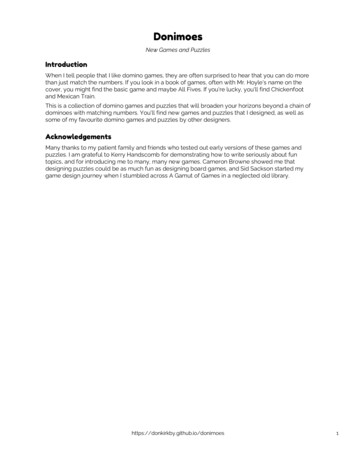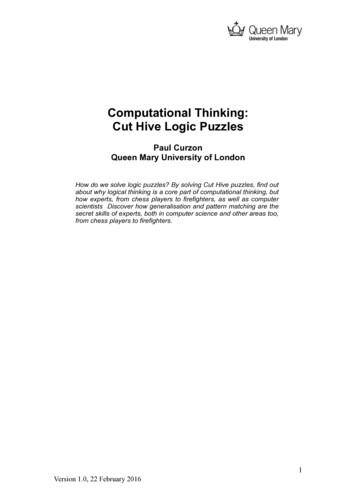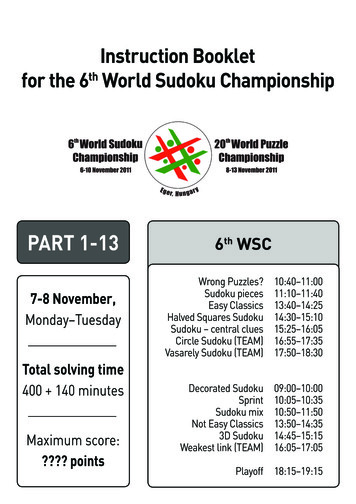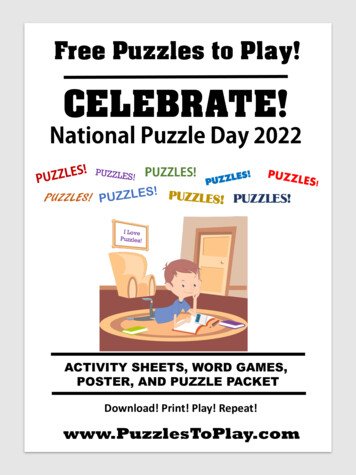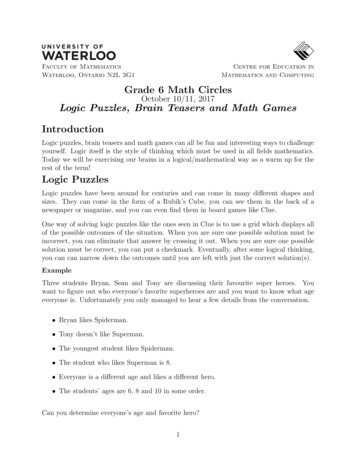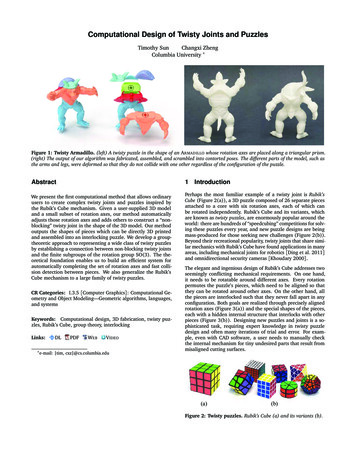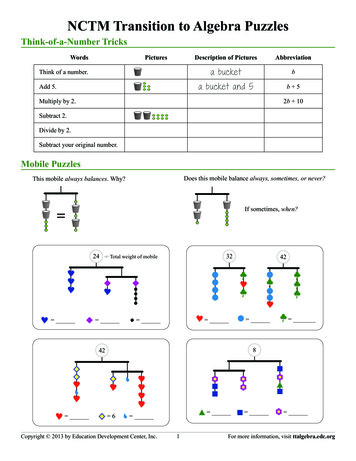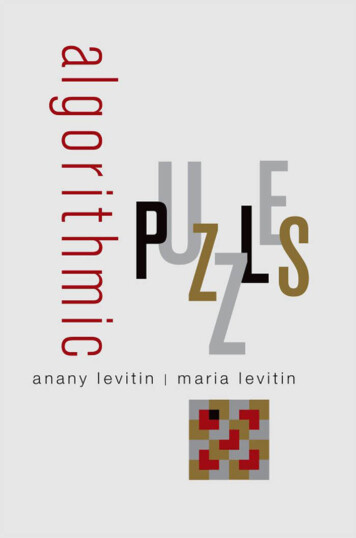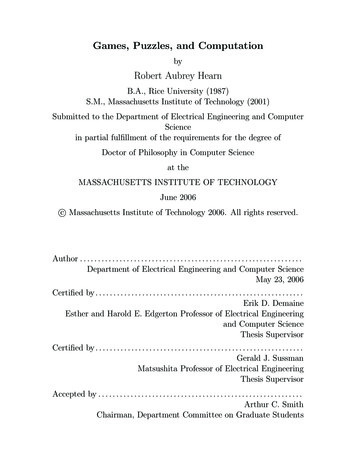
Transcription
Games, Puzzles, and ComputationbyRobert Aubrey HearnB.A., Rice University (1987)S.M., Massachusetts Institute of Technology (2001)Submitted to the Department of Electrical Engineering and ComputerSciencein partial fulfillment of the requirements for the degree ofDoctor of Philosophy in Computer Scienceat theMASSACHUSETTS INSTITUTE OF TECHNOLOGYJune 2006c Massachusetts Institute of Technology 2006. All rights reserved.Author . . . . . . . . . . . . . . . . . . . . . . . . . . . . . . . . . . . . . . . . . . . . . . . . . . . . . . . . . . . . . .Department of Electrical Engineering and Computer ScienceMay 23, 2006Certified by . . . . . . . . . . . . . . . . . . . . . . . . . . . . . . . . . . . . . . . . . . . . . . . . . . . . . . . . . .Erik D. DemaineEsther and Harold E. Edgerton Professor of Electrical Engineeringand Computer ScienceThesis SupervisorCertified by . . . . . . . . . . . . . . . . . . . . . . . . . . . . . . . . . . . . . . . . . . . . . . . . . . . . . . . . . .Gerald J. SussmanMatsushita Professor of Electrical EngineeringThesis SupervisorAccepted by . . . . . . . . . . . . . . . . . . . . . . . . . . . . . . . . . . . . . . . . . . . . . . . . . . . . . . . . .Arthur C. SmithChairman, Department Committee on Graduate Students
Games, Puzzles, and ComputationbyRobert Aubrey HearnSubmitted to the Department of Electrical Engineering and Computer Scienceon May 23, 2006, in partial fulfillment of therequirements for the degree ofDoctor of Philosophy in Computer ScienceAbstractThere is a fundamental connection between the notions of game and of computation.At its most basic level, this is implied by any game complexity result, but the connection is deeper than this. One example is the concept of alternating nondeterminism,which is intimately connected with two-player games.In the first half of this thesis, I develop the idea of game as computation to agreater degree than has been done previously. I present a general family of games,called Constraint Logic, which is both mathematically simple and ideally suited forreductions to many actual board games. A deterministic version of Constraint Logiccorresponds to a novel kind of logic circuit which is monotone and reversible. Atthe other end of the spectrum, I show that a multiplayer version of Constraint Logicis undecidable. That there are undecidable games using finite physical resources isphilosophically important, and raises issues related to the Church-Turing thesis.In the second half of this thesis, I apply the Constraint Logic formalism to manyactual games and puzzles, providing new hardness proofs. These applications includesliding-block puzzles, sliding-coin puzzles, plank puzzles, hinged polygon dissections,Amazons, Konane, Cross Purposes, TipOver, and others. Some of these have beenwell-known open problems for some time. For other games, including Minesweeper,the Warehouseman’s Problem, Sokoban, and Rush Hour, I either strengthen existingresults, or provide new, simpler hardness proofs than the original proofs.Thesis Supervisor: Erik D. DemaineTitle: Esther and Harold E. Edgerton Professor of Electrical Engineering and Computer ScienceThesis Supervisor: Gerald J. SussmanTitle: Matsushita Professor of Electrical Engineering2
AcknowledgmentsThis work would not have been possible without the contributions of very manypeople. Most directly, I started on this line of research at the suggestion of ErikDemaine, who mentioned that the complexity of sliding-block puzzles was open, andthat Gary Flake and Eric Baum’s paper on the complexity of Rush Hour might be asource of good ideas for attacking the problem. This intuition proved to be spot-on,but neither Erik nor I had any idea how many more results would follow in naturalprogression.But before this work began, I was already well-suited to head down this path. Iacquired an early interest in games and puzzles, particularly with a mathematical flavor, primarily through Martin Gardner’s “Mathematical Games” column in ScientificAmerican, and his many books. My early interest in the theory of computation isharder for me to pin down, but it was certainly dependent on having access to computers, which most children of my generation did not. I have my parents, particularlymy father, to thank for this, as well as for exposure to the Martin Gardner books.During high school my good friend Warren Wood was a fellow traveler; we inventedmany an interesting (and often silly) mathematical game together.Later, I grew to love the beautiful mathematics of Combinatorial Game Theory,developed by Elwyn Berlekamp, John Conway, and Richard Guy. I am also gratefulfor many enjoyable and useful discussions with Elwyn, John, and Richard, whicharose later during this work’s development.My interest in the theory of computation was rekindled when I returned to schoolafter several years in the software industry, and took Michael Sipser’s Theory ofComputation course. Before this, I viewed NP-completeness as deep, mysteriousmath. I understood the concept, but the thought that I might someday show a realproblem to be NP-complete—or even harder—was not one I had seriously entertained.In Michael’s course I gained a clearer appreciation for how such reductions were done.It was in this context that I had the good fortune to TA MIT’s Introduction toAlgorithms course for Charles Leiserson and Erik Demaine. I was put in charge ofthe class programming contest, and I chose puzzle design as the domain. This ledto discussions of game and puzzle complexity with Erik, and eventually to all of thepresent work. I also learned the great value of teaching from Charles and Erik. Thereis nothing like having to teach MIT students algorithms to keep you on your toes andmake the material come alive for you.Meanwhile, however, I was working on my “primary” research, implementing Marvin Minsky’s “Society of Mind”. I thank Marvin for his encouragement, and GerrySussman for his patience as I discovered as so many before me have that solving AI isnot the task of a few years in grad school. I also have Gerry to thank for ultimatelyencouraging me to assemble my game and puzzle work into a Ph.D. thesis, and Ialso thank Erik for respectfully refraining from a similar suggestion until I raised thepossibility with him, based on his understanding of my reason for being at MIT.After my initial results on puzzles, Albert Meyer and Shafi Goldwasser served asmy RQE committee, and offered many useful perspectives, as well providing me withan extra sense of the legitimacy of my work and my ability to communicate it.3
I am grateful to my coauthors on the work presented here: Erik Demaine, MichaelHoffman, Greg Frederickson, Martin Demaine, Rudolf Fleischer, and Timo von Oertzen.I learned a lot through collaboration that it would be virtually impossible to learnotherwise. Marty Demaine has also always had something interesting going on todiscuss, and has offered excellent life advice on many occasions.As I began to get results, I met many other interesting people in the mathematicalgames community. I am especially fortunate to have met John Tromp and MichaelAlbert, who have become good friends, in addition to providing many valuable insights. Other “games people” I have enjoyed many discussions with and learned frominclude Richard Nowakowsi, Aviezri Fraenkel, J. P. Grossman, Aaron Seigel, CyrilBanderier, and Ed Pegg.I want to especially thank Ivars Peterson for helping to popularize some of mywork in Science News and Math Trek, and making me aware of the wider interestin this kind of work. Similarly, thanks are due to Michael Kleber for inviting me towrite an article for Mathematical Intelligencer.Of my many fellow grad students at MIT, I want to thank Jake Beal, JustinWerfel, Attila Kondacs, Ian Eslick, Radhika Nagpal, Paulina Varshavskaia, RebeccaFrankel, and Keith Winstein for helping to make the journey more pleasant. Twoformer students, Erik Rauch, who was my officemate, and Push Singh, who was agood friend and sometimes mentor in my Society of Mind work, both left this worldbefore their time. Both, however, had a big positive effect on me, and many others.I want to thank Tom Knight, Norm Margolus, and Ed Fredkin for enlighteningconversations about reversible computing, among other topics.My wife Liz deserves special thanks for being patient as I kept trying to solveimpossible problems on the one hand, and screwing around with silly games on theother. Finally, Liz, I’ve made something of all that playing around with games!Last but not least, I am very appreciative of my committee. Gerry Sussman wasmy advisor from the moment I arrived at MIT, and it has been my great privilege toshare many hours of discussion with Gerry on virtually every subject that is interesting, and many evenings of fine astronomy as well. Erik Demaine has been incredibleto know and to work with. He has an amazing ability to point people in just the rightdirection, so that they will find interesting things. Every time I had a new result, Iwould take it to Erik, and he would say,“yes, cool! Now, did you think about this?”,and I would be off on another hunt. Marvin Minsky has been a major source ofinspiration for me for more than 20 years. I hope to revive my Society of Mind work;I still feel that this book is the single best source of insights on how to think aboutintelligence. I am still somewhat astounded that I am able to just talk to Marvinlike an ordinary person. Similarly, it has been an honor to have Patrick Winston onmy committee. I have learned a lot about effective writing and communication, aswell as AI, from Patrick. Marvin and Patrick deserve extra thanks for remaining onmy committee when I switched topics from AI to game complexity. Finally, MichaelSipser, though a late addition to the committee, has been a valuable presence. Ilearned a great deal in his course—including a lot that I thought I already knew!And Michael also had valuable comments for me when he graciously agreed to joinmy committee, in spite of his load as head of the Mathematics department.4
Contents1 Introduction10I12Games in General2 What is a Game?143 The Constraint Logic Formalism3.1 Constraint Graphs . . . . . . . . . . . . . . . . . . . . . . . . . . . .3.2 Constraint Graph Conversion Techniques . . . . . . . . . . . . . . . .1819214 Zero-Player Games (Simulations)4.1 Bounded Games . . . . . . . . . . . . . .4.1.1 P-completeness . . . . . . . . . .4.1.2 Planar Graphs . . . . . . . . . .4.2 Unbounded Games . . . . . . . . . . . .4.2.1 PSPACE-completeness . . . . . .4.2.2 Planar Graphs . . . . . . . . . .4.2.3 Efficient Reversible Computation.24242526262835365 One-Player Games (Puzzles)5.1 Bounded Games . . . . . . . . . . . . . . . . . .5.1.1 NP-completeness . . . . . . . . . . . . .5.1.2 Planar Graphs . . . . . . . . . . . . . .5.1.3 An Alternate Vertex Set . . . . . . . . .5.2 Unbounded Games . . . . . . . . . . . . . . . .5.2.1 PSPACE-completeness . . . . . . . . . .5.2.2 Planar Graphs . . . . . . . . . . . . . .5.2.3 Protected OR Graphs . . . . . . . . . . .5.2.4 Configuration-to-Configuration Problem.383939414142434749506 Two-Player Games6.1 Bounded Games . . . . . . . . .6.1.1 PSPACE-completeness .6.1.2 Planar Graphs . . . . .6.1.3 An Alternate Vertex Set.5253545656.5.
6.2.575861617 Team Games7.1 Bounded Games . . . . . . . . . . . . . .7.2 Unbounded Games . . . . . . . . . . . .7.2.1 Incorrectness of Existing Results7.2.2 Undecidability . . . . . . . . . . .7.2.3 Planar Graphs . . . . . . . . . .6364646669768 Summary of Part I8.1 Hierarchies of Complete Problems . . . . . . . . . . . . . . . . . . . .8.2 Games, Physics, and Computation . . . . . . . . . . . . . . . . . . .777778II816.3Unbounded Games . . . . . . .6.2.1 EXPTIME-completeness6.2.2 Planar Graphs . . . . .No-Repeat Games . . . . . . . .Games in Particular9 One-Player Games (Puzzles)9.1 TipOver . . . . . . . . . . . . . . . .9.1.1 NP-completeness . . . . . . .9.2 Sliding-Block Puzzles . . . . . . . . .9.2.1 PSPACE-completeness . . . .9.3 The Warehouseman’s Problem . . . .9.3.1 PSPACE-completeness . . . .9.4 Sliding-Coin Puzzles . . . . . . . . .9.4.1 PSPACE-completeness . . . .9.5 Plank Puzzles . . . . . . . . . . . . .9.5.1 PSPACE-completeness . . . .9.6 Sokoban . . . . . . . . . . . . . . . .9.6.1 PSPACE-completeness . . . .9.7 Rush Hour . . . . . . . . . . . . . . .9.7.1 PSPACE-completeness . . . .9.7.2 Generalized Problem Bounds9.8 Triangular Rush Hour . . . . . . . .9.9 Hinged Polygon Dissections . . . . .9.10 Additional Results . . . . . . . . . .9.10.1 Push-2F . . . . . . . . . . . .9.10.2 Dyson Telescope Game . . . 610 Two-Player Games10710.1 Amazons . . . . . . . . . . . . . . . . . . . . . . . . . . . . . . . . . . 10710.1.1 PSPACE-completeness . . . . . . . . . . . . . . . . . . . . . . 10810.2 Konane . . . . . . . . . . . . . . . . . . . . . . . . . . . . . . . . . . 1116
10.2.1 PSPACE-completeness . . . . . . . . . . . . . . . . . . . . . . 11210.3 Cross Purposes . . . . . . . . . . . . . . . . . . . . . . . . . . . . . . 11410.3.1 PSPACE-completeness . . . . . . . . . . . . . . . . . . . . . . 11511 Open Problems12012 Summary of Part II12413 Conclusions12513.1 Contributions . . . . . . . . . . . . . . . . . . . . . . . . . . . . . . . 12513.2 Future Work . . . . . . . . . . . . . . . . . . . . . . . . . . . . . . . . 126A Computational Complexity ReferenceA.1 Basic Definitions . . . . . . . . . . . . . . . .A.2 Generalizations of Turing Machines . . . . . .A.3 Relationship of Complexity Classes . . . . . .A.4 List of Complexity Classes Used in this ThesisA.5 Formula Games. . . . . . . . . . . . . . . . . .A.5.1 Boolean Formulas. . . . . . . . . . . .A.5.2 Satisfiability (SAT). . . . . . . . . . .A.5.3 Quantified Boolean Formulas (QBF). .B Deterministic Constraint Logic Activation Sequences7.128128130133133134134134135136
List of Figures1-1 Table of Constraint Logic game categories and complexities . . . . . .133-13-23-33-4Red-blue vertex conversion . . . . . . . . . . . . . . . . . . . . . . . .How to terminate loose edges. . . . . . . . . . . . . . . . . . . . . . .202122234-14-24-34-44-54-6Schematic of reduction from QBF. . .DCL quantifier gadgets. . . . . . . .DCL AND0 and OR0 gadgets. . . . . .Additional CNF gadgets. . . . . . . .DCL crossover gadget. . . . . . . . .DCL reversible computation gadgets.2830323435375-15-25-35-45-55-65-75-85-9A constraint graph corresponding to a formula . . . . . . . . . . . . .Distinct types of AND/OR vertex used in the Bounded NCL reduction.An equivalent set of vertices, better suited for reductions. . . . . . . .Schematic of the reduction from Quantified Boolean Formulas to NCL.QBF wiring. . . . . . . . . . . . . . . . . . . . . . . . . . . . . . . . .Latch gadget, transitioning from state A to state B. . . . . . . . . . .Quantifier gadgets. . . . . . . . . . . . . . . . . . . . . . . . . . . . .Planar crossover gadgets. . . . . . . . . . . . . . . . . . . . . . . . . .OR vertex made with protected OR vertices. . . . . . . . . . . . . . .4041414344454648506-16-26-36-4A constraint graph corresponding to a Gpos (POS CNF) formula gameA sufficient set of vertex types for reductions from Bounded 2CL. . .Reduction from G6 to 2CL. . . . . . . . . . . . . . . . . . . . . . . .Path-length-equalizer gadget. . . . . . . . . . . . . . . . . . . . . . .555658597-1 Reduction from TEAM FORMULA GAME to TPCL . . . . . . . . .7-2 Additional gadgets for TPCL reduction. . . . . . . . . . . . . . . . .73749-19-29-39-49-58384858586AND and OR vertices . . . . . . . . . . . . . . . . . . . . . . . . . . .CHOICE vertex conversion. . . . . . . . . . . . . . . . . . . . . . . . .TipOver puzzle. . . . . . . . . . . . . . . . . . . . . . . .A sample TipOver puzzle and its solution. . . . . . . . .A wire that must be initially traversed from left to rightTipOver AND and OR gadgets. . . . . . . . . . . . . . . .How to use the AND gadget. . . . . . . . . . . . . . . . .8.
199-209-21TipOver CHOICE gadget . . . . . . . . . . . . .TipOver puzzle for a simple constraint graph. .Dad’s Puzzle. . . . . . . . . . . . . . . . . . . .Sliding Blocks layout. . . . . . . . . . . . . . . .Sliding Blocks vertex gadgets. . . . . . . . . . .Sliding Blocks wiring. . . . . . . . . . . . . . . .Sliding Tokens vertex gadgets. . . . . . . . . . .A plank puzzle. . . . . . . . . . . . . . . . . . .Plank-puzzle AND and OR vertices. . . . . . . .A plank puzzle made from an AND/OR graph. .The equivalent constraint graph for Figure 9-15.Sokoban gadgets. . . . . . . . . . . . . . . . . .Rush Hour layout and vertex gadgets. . . . . . .Triagonal Slide-Out gadgets. . . . . . . . . . . .How the gadgets are connected together. . . . .Dudeney’s hinged triangle-to-square dissection. .86878889909294959596979910110310410510-1 Amazons start position and typical endgame position. . .10-2 Amazons wiring gadgets. . . . . . . . . . . . . . . . . . .10-3 Amazons logic gadgets. . . . . . . . . . . . . . . . . . . .10-4 Amazons FANOUT gadget. . . . . . . . . . . . . . . . . .10-5 Amazons victory gadget. . . . . . . . . . . . . . . . . . .10-6 Konane wiring gadgets. . . . . . . . . . . . . . . . . . . .10-7 Konane variable, OR, and CHOICE gadgets. . . . . . . . .10-8 An initial Cross Purposes configuration, and two moves.10-9 Cross Purposes wiring. . . . . . . . . . . . . . . . . . . .10-10Cross Purposes conditional gadget. . . . . . . . . . . . .10-11Cross Purposes variable, OR, and CHOICE gadgets. . . . .10-12Protected Or. . . . . . . . . . . . . . . . . . . . . . . . .108109110110111113114115116117118118B-1 Switch gadget steps . . . . . . . . . . . . . . . . . . . . . . . . . .B-2 Existential quantifier steps . . . . . . . . . . . . . . . . . . . . . .B-3 Universal quantifier steps, part one . . . . . . . . . . . . . . . . .B-4 Universal quantifier steps, part two . . . . . . . . . . . . . . . . .B-5 Universal quantifier steps, part three . . . . . . . . . . . . . . . .B-6 AND0 steps, in the case when both inputs activate in sequence . .B-7 AND0 steps, when input 2 activates without input 1 first activatingB-8 OR0 steps, part one . . . . . . . . . . . . . . . . . . . . . . . . . .B-9 OR0 steps, part two . . . . . . . . . . . . . . . . . . . . . . . . . .B-10 OR0 steps, part three . . . . . . . . . . . . . . . . . . . . . . . . .B-11 Crossover gadget steps . . . . . . . . . . . . . . . . . . . . . . . .1381391401411411421421431441451469.
Chapter 1IntroductionIn this thesis I argue that there are deep connections between the idea of game andthe idea of computation, and indeed that games should be thought of as a valid andimportant model of computation, just as Turing machines are.It is trivially true that any problem shown to be NP-hard, PSPACE-hard, etc. hasan inherent computational flavor, merely by virtue of the (often indirect) reductionfrom some kind of resource-bounded Turing machine. Given this, the fact that manygames (such as Chess, Checkers, and Go) have been shown to be hard would not seemto argue for a special connection between games as such and computation. One mightas well, it seems, argue that graphs are inherently computational, because there aremany hard graph problems.However, it is a curious fact that various kinds of games seem to be in especiallydirect correspondence with particular models of computation. For example, the notionof nondeterminism inherent in NP-completeness nicely matches the feature of puzzlesthat a player must choose a sequence of moves or piece placements to satisfy someglobal property. Even more striking is the correspondence between alternation, thenatural extension to nondeterminism, and two-player games [8].These connections have been pointed out before. Reif [64], and Peterson, Reif,and Azhar [60], suggest that games should be considered as a model of computation,and they explicitly list a taxonomy of games types and corresponding models ofcomputation, culminating in team games of private information, which correspond tounbounded deterministic Turing machines.My primary contribution, developed in Part I, is to present an explicit, uniformmodel of abstract game, called Constraint Logic, which has as natural specializationszero-player games (deterministic simulations), one-player games (puzzles), two-playergames, et cetera. In each case I show that my game is complete for the appropriatecomplexity class, or, in the case of team games of private information, undecidable.In fact, this last game is arguably the first game, in a particular, reasonable sense,11Specifically, the game must have a finite number of positions, and players must alternate turns.No previously known undecidable problem, to my knowledge, has both these properties. Petersonand Reif’s game Team-Peek [60] is described to have those properties, but there is an implicitassumption in the construction that players do not take turns in sequence. (Also there is a mistakein the definition; as defined, the game is trivially decidable.) See Chapter 7.10
to be shown undecidable. The fact that there are such undecidable games using finiteresources highlights the difference between games and Turing machines, and is thelinchpin in the argument for viewing games as a model of computation.In addition to filling a natural slot in the game complexity hierarchy, the deterministic version of Constraint Logic also turns out to be a new, interesting model ofcomputation in its own right. It is reversible and monotone, and may potentially havepractical application for building real computers with very low power consumption.Constraint Logic is also naturally suited for reductions to actual board games, andan additional contribution of this thesis, in Part II, is a large collection of new gamehardness proofs based on the various flavors of Constraint Logic. Constraint Logic isa game played on a directed graph; a move is to reverse the direction of an edge. Oneespecially useful property of these graphs is that in all cases but one, the completenessresults hold even for planar graphs. This greatly simplifies many game reductions, insome cases making trivial what was previously intricately complex.Another curious property of games (or perhaps of their players), which becomesevident in Part II, is that a given game will tend to be as hard as possible givenits general characteristics. For example, if a game is a one-player puzzle with abounded length, odds are it is NP-complete. If it is a two-player game with anunbounded length, it will generally be EXPTIME-complete. And so on. This isperhaps a reflection on human psychology as much as anything; a game would not beinteresting if it were not hard.Hardness results are called “negative” results, as opposed to “positive” resultsshowing how to efficiently solve problems; one feeling in the mathematical gamescommunity is that once a game has been shown hard, there is no point studyingit further. But from the computational perspective of this thesis, and taking thepreceding paragraph into consideration, showing a game to be hard validates it as anobject worthy of interest and further study.11
Part IGames in General12
Part I of this thesis develops the Constraint Logic model of computation in its various flavors. These comprise instances in a two-dimensional space of game categories,shown in Figure 1-1. The first dimension ranges across zero-player games (deterministic simulations), one-player games (puzzles), two-player games, and team games withprivate information. The second dimension is whether the game has (polynomially)bounded length. In all cases, the games use bounded space; the basic idea is that agame involves pieces moving around, being placed, or being captured, on a board orother space of fixed ePNPPSPACENEXPTIMEZero player(simulation)One player(puzzle)Two playerTeam,imperfectinformationFigure 1-1: Table of Constraint Logic game categories and complexities. Each gametype is complete for the indicated class. (After [61].)Chapter 2 considers various notions of games, and describes the kinds of games,generalized combinatorial games, that will be studied here. Chapter 3 defines thegeneral Constraint Logic model of computation. Chapters 4–7 develop notions ofgame ranging from deterministic simulations to team games of private information,and provide corresponding complexity results for appropriate versions of ConstraintLogic.2Chapter 8 summarizes the results in Part I, and explores some of their implications.2One result, NEXPTIME-completeness for Bounded Team Private Constraint Logic, is merelyconjectured.13
Chapter 2What is a Game?The goal of this thesis is to investigate the computational characteristics of gamesand puzzles such as Chess, Checkers, Go, Hex, Bridge, sliding-block puzzles, Conway’sGame of Life, . . . but what exactly is a game?Game Theory. There are innumerable kinds of activities and situations that mightbe described as games. A large portion of these may be studied within the contextof classical game theory. However, the games I wish to consider are both morespecialized and more general than what is traditionally addressed by game theory.More specialized, because I shall only be concerned with determining the winner of agame, and not with other issues of interest in game theory such as maximizing payoff,studying cooperative strategies, etc. More general, because game theory is concernedonly with the interactions of two or more players, whereas I will consider gameswith only one player (puzzles) and even with no players at all (simulations). Otherdifferences are that game theory generally formulates games in either “strategic”form (by exhaustively listing the strategies for each player) or “extensive” form (byanalyzing the explicit game tree). But for the games I consider both forms would beexponentially large, or even infinite.Combinatorial Games. Instead, in order to explore the connection between gamesand computation, I will study games from a computational complexity standpoint.Naturally, then, these games will have a combinatorial aspect. Indeed, we mightsimply call them “combinatorial games”, except for the fact that there is already anestablished field called Combinatorial Game Theory [4, 9], and many of the kinds ofgames I will consider fall outside the domain of this field. A combinatorial game isdefined to be a two-player, perfect-information game with no chance elements [25].By so restricting the notion of game, Combinatorial Game Theory is able to drawout beautiful and unexpected relationships between games and numbers—indeed, inthat framework a number is simply a special kind of game. But other “games” witha combinatorial flavor, such as sliding-block puzzles, or Conway’s Game of Life, orBridge, violate these restrictions, yet are interesting to study from a computationalperspective.14
Notion of a Game. At the risk of being insufficiently specific, I will avoid formallydefining a notion of game. The reason is that it is difficult, if not impossible, to besure there is not some further reasonable generalization of the concept of game thatcould not be studied by further generalization of the techniques presented in thisthesis.For example, in a seminal paper on game complexity [81], Stockmeyer and Chandra define a notion of “reasonable game”, and demonstrate formula games that are“universal” for such games. These formula games provably require exponential timeto determine the winner.However, shortly afterward Reif [64] generalized the notion of game to includeimperfect information,1 relabeled Stockmeyer and Chandra’s “reasonable games” as“reasonable games of perfect information”, and demonstrated formula games thatare “universal for all reasonable games”, where the notion of imperfect informationhas been added. Reif’s formula games are complete in doubly-exponential time—exponentially harder to decide than even the provably intractable games that previously were all that was “reasonable”.And then again, shortly afterwards, Peterson and Reif [61] noted that “the generalization to more than two players is to have two teams, A and B”, and showed thatsuch games can in general be undecidable.2 This is, in my view, a very deep result,and one I will explore in detail in Chapters 7 and 8.But the point is that there always seems to be another generalization of whatconstitutes a “reasonable” game. The limit may seem to have been reached withPeterson and Reif’s undecidable games, b
In the second half of this thesis, I apply the Constraint Logic formalism to many actual games and puzzles, providing new hardness proofs. These applications include sliding-block puzzles, sliding-coin puzzles, plank puzzles, hinged polygon dissections, . Later, I grew to love the beautiful mathematics of Combinatorial Game Theory, developed .
